SD-VIS: A Fast and Accurate Semi-Direct Monocular Visual-Inertial Simultaneous Localization and Mapping (SLAM)
Abstract
1. Introduction
2. System Framework Overview
3. IMU Measurements and Visual-Inertial Alignment
3.1. Definition of Symbols
3.2. IMU Pre-Integration
3.3. Visual-Inertial Alignment
3.3.1. Gyroscope Bias Correction
3.3.2. Gravity Vector, Initial Velocity, and Metric Scale Correction
3.3.3. Gravity Vector Refinement
4. Visual Measurements
4.1. Keyframe Selection
4.2. Keyframes Tracking
4.3. Non-Keyframes Tracking
5. Sliding Window-based Tightly-coupled Optimization Framework
5.1. Formulation
5.2. IMU Residuals
5.3. Visual Re-Projection Errors
5.4. Marginalization Strategy
5.5. Re-Localization
6. Experiment
6.1. Accuracy and Robustness Evaluate
6.2. Real-Time Performance Evaluate
6.3. Loop Closure Detection Evaluate
7. Conclusions
Author Contributions
Funding
Acknowledgments
Conflicts of Interest
References
- Fuentes-Pacheco, J.; Ruiz-Ascencio, J.; Manuel Rendon-Mancha, J. Visual simultaneous localization and mapping: A survey. Artif. Intell. Rev. 2012, 43, 55–81. [Google Scholar] [CrossRef]
- Bailey, T.; Durrant-Whyte, H. Simultaneous localization and mapping (SLAM): Part II. IEEE Robot. Autom. Mag. 2006, 13, 108–117. [Google Scholar] [CrossRef]
- Wang, R.; Schworer, M.; Cremers, D. Stereo DSO: Large-scale direct sparse visual odometry with stereo cameras. In Proceedings of the IEEE International Conference on Computer Vision, Venice, Italy, 22–29 October 2017; pp. 3903–3911. [Google Scholar]
- Wang, X.; Wang, J. Detecting glass in simultaneous localization and mapping. Robot. Auton. Syst. 2017, 88, 97–103. [Google Scholar] [CrossRef]
- Titterton, D.; Weston, J.L. Strapdown Inertial Navigation Technology; The Institution of Engineering and Technology: Stevenage, UK, 2004; Volume 17. [Google Scholar]
- Davison, A.J.; Reid, I.D.; Molton, N.D.; Stasse, O. MonoSLAM: Real-Time Single Camera SLAM. IEEE Trans. Pattern Anal. Mach. Intell. 2007, 29, 1052–1067. [Google Scholar] [CrossRef]
- Lee, T.; Kim, C.; Cho, D.D. A Monocular Vision Sensor-Based Efficient SLAM Method for Indoor Service Robots. IEEE Trans. Ind. Electron. 2019, 66, 318–328. [Google Scholar] [CrossRef]
- Shen, S.J.; Michael, N.; Kumar, V. Tightly-Coupled Monocular Visual-Inertial Fusion for Autonomous Flight of Rotorcraft MAVs. In Proceedings of the 2015 IEEE International Conference on Robotics and Automation (ICRA), Seattle, WA, USA, 26–30 May 2015; pp. 5303–5310. [Google Scholar]
- Leutenegger, S.; Lynen, S.; Bosse, M.; Siegwart, R.; Furgale, P. Keyframe-based visual-inertial odometry using nonlinear optimization. Int. J. Robot. Res. 2015, 34, 314–334. [Google Scholar] [CrossRef]
- Mur-Artal, R.; Montiel, J.M.M.; Tardos, J.D. ORB-SLAM: A Versatile and Accurate Monocular SLAM System. IEEE Trans. Robot. 2015, 31, 1147–1163. [Google Scholar] [CrossRef]
- Engel, J.; Koltun, V.; Cremers, D. Direct sparse odometry. IEEE Trans. Pattern Anal. Mach. Intell. 2018, 40, 611–625. [Google Scholar] [CrossRef] [PubMed]
- Usenko, V.; Engel, J.; Stuckler, J.; Cremers, D. Direct Visual-Inertial Odometry with Stereo Cameras. In Proceedings of the 2016 IEEE International Conference on Robotics and Automation (ICRA), Stockholm, Sweden, 16–21 May 2016; pp. 1885–1892. [Google Scholar]
- Falquez, J.M.; Kasper, M.; Sibley, G. Inertial Aided Dense & Semi-Dense Methods for Robust Direct Visual Odometry. In Proceedings of the IEEE/RSJ International Conference on Intelligent Robots & Systems, Daejeon, Korea, 9–14 October 2016; pp. 3601–3607. [Google Scholar]
- Newcombe, R.A.; Lovegrove, S.J.; Davison, A.J. DTAM: Dense tracking and mapping in real-time. In Proceedings of the 2011 IEEE International Conference on Computer Vision (ICCV), Barcelona, Spain, 6–13 November 2011; pp. 2320–2327. [Google Scholar]
- Lucas, B.D.; Kanade, T. An iterative image registration technique with an application to stereo vision. In Proceedings of the International Joint Conference on Artificial Intelligence, Vancouver, BC, Canada, August 1981; pp. 24–28. [Google Scholar]
- Klein, G.; Murray, D. Parallel tracking and mapping for small AR workspaces (PTAM). In Proceedings of the 2007 6th IEEE and ACM International Symposium on Mixed and Augmented Reality, Washington, DC, USA, 13–16 November 2007; pp. 1–10. [Google Scholar]
- Mur-Artal, R.; Tardos, J.D. ORB-SLAM2: An Open-Source SLAM System for Monocular, Stereo, and RGB-D Cameras. IEEE Trans. Robot. 2017, 33, 1255–1262. [Google Scholar] [CrossRef]
- Qin, T.; Li, P.; Shen, S. VINS-Mono: A Robust and Versatile Monocular Visual-Inertial State Estimator. IEEE Trans. Robot. 2018, 34, 1004–1020. [Google Scholar] [CrossRef]
- He, Y.; Zhao, J.; Guo, Y.; He, W.; Yuan, K. Pl-VIO: Tightly coupled monocular visual inertial odometry using point and line features. Sensors 2018, 18, 1159. [Google Scholar] [CrossRef] [PubMed]
- Qin, T.; Pan, J.; Cao, S.; Shen, S.J. A General Optimization-based Framework for Local Odometry Estimation with Multiple Sensors. arXiv Preprint 2019, arXiv:1901.03638. [Google Scholar]
- Engel, J.; Schöps, T.; Cremers, D. LSD-SLAM: Large-scale direct monocular SLAM. In Proceedings of the European Conference on Computer Vision, Zurich, Switzerland, 6–12 September 2014; pp. 834–849. [Google Scholar]
- Gao, X.; Wang, R.; Demmel, N.; Cremers, D. LDSO: Direct Sparse Odometry with Loop Closure. In Proceedings of the International Conference on Intelligent Robots and Systems (IROS), Madrid, Spain, 1–5 October 2018. [Google Scholar]
- Forster, C.; Pizzoli, M.; Scaramuzza, D. SVO: Fast semi-direct monocular visual odometry. In Proceedings of the 2014 IEEE International Conference on Robotics and Automation (ICRA), Hong Kong, China, 31 May–5 June 2014; pp. 15–22. [Google Scholar]
- Lee, S.H.; Civera, J. Loosely-coupled semi-direct monocular slam. arXiv Preprint 2018, arXiv:1807.10073. [Google Scholar] [CrossRef]
- Krombach, N.; Droeschel, D.; Houben, S.; Behnke, S. Feature based visual odometry prior for real-time semi-dense stereo slam. Robot. Auton. Syst. 2018, 109, 38–58. [Google Scholar] [CrossRef]
- Kim, O.; Lee, H.; Kim, H.J. Autonomous flight with robust visual odometry under dynamic lighting conditions. Auton. Robot. 2019, 43, 1605–1622. [Google Scholar] [CrossRef]
- Li, S.P.; Zhang, T.; Gao, X.; Wang, D.; Xian, Y. Semi-direct monocular visual and visual-inertial SLAM with loop closure detection. Robot. Auton. Syst. 2019, 112, 201–202. [Google Scholar] [CrossRef]
- Shi, J. Good features to track. In Proceedings of the 1994 IEEE Computer Society Conference on Computer Vision and Pattern Recognition (CVPR’94), Seattle, WA, USA, 21–23 June 1994; pp. 593–600. [Google Scholar]
- Hartley, R.; Zisserman, A. Multiple View Geometry in Computer Vision; Cambridge University Press: Cambridge, UK, 2003. [Google Scholar]
- Baker, S.; Matthews, I. Lucas-Kanade 20 Years On: A Unifying Framework: Part 1. Int. J. Comput. Vis. 2002, 56, 221–255. [Google Scholar] [CrossRef]
- Sibley, G.; Matthies, L.; Sukhatme, G. Sliding window filter with application to planetary landing. J. Field Robot. 2010, 27, 587–608. [Google Scholar] [CrossRef]
- Burri, M.; Nikolic, J.; Gohl, P.; Schneider, T.; Rehder, J.; Omari, S.; Achtelik, M.W.; Siegwart, R. The EuRoC micro aerial vehicle datasets. Int. J. Robot. Res. 2016, 35, 1157–1163. [Google Scholar] [CrossRef]
- Michael Grupp. EVO. Available online: https://github.com/MichaelGrupp/evo (accessed on 8 August 2019).
- Sturm, J.; Engelhard, N.; Endres, F.; Burgard, W.; Cremers, D. A benchmark for the evaluation of RGB-D SLAM systems. In Proceedings of the 2012 IEEE/RSJ International Conference on Intelligent Robots and Systems (IROS), Vilamoura, Portugal, 7–12 October 2012; pp. 573–580. [Google Scholar]
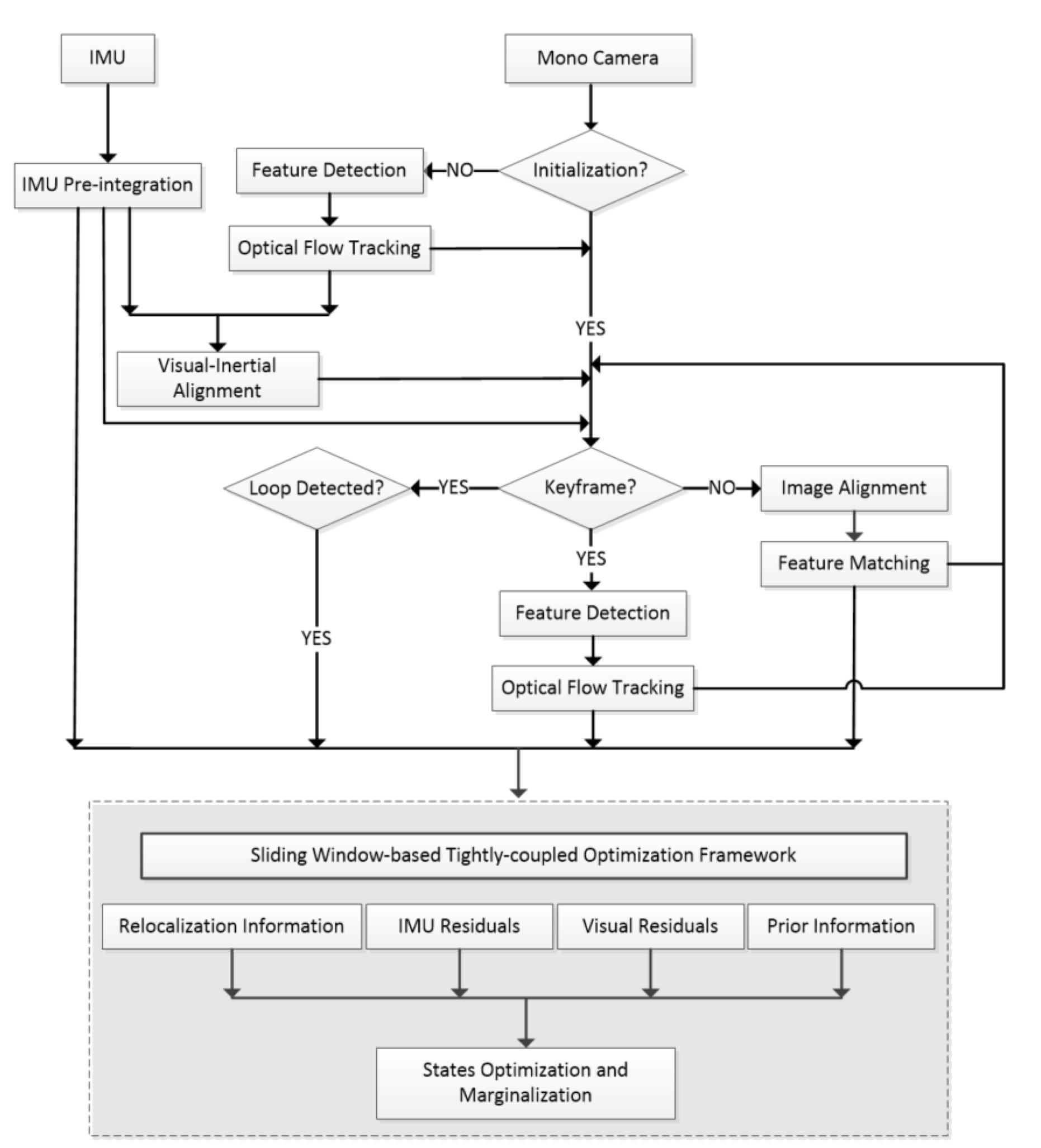
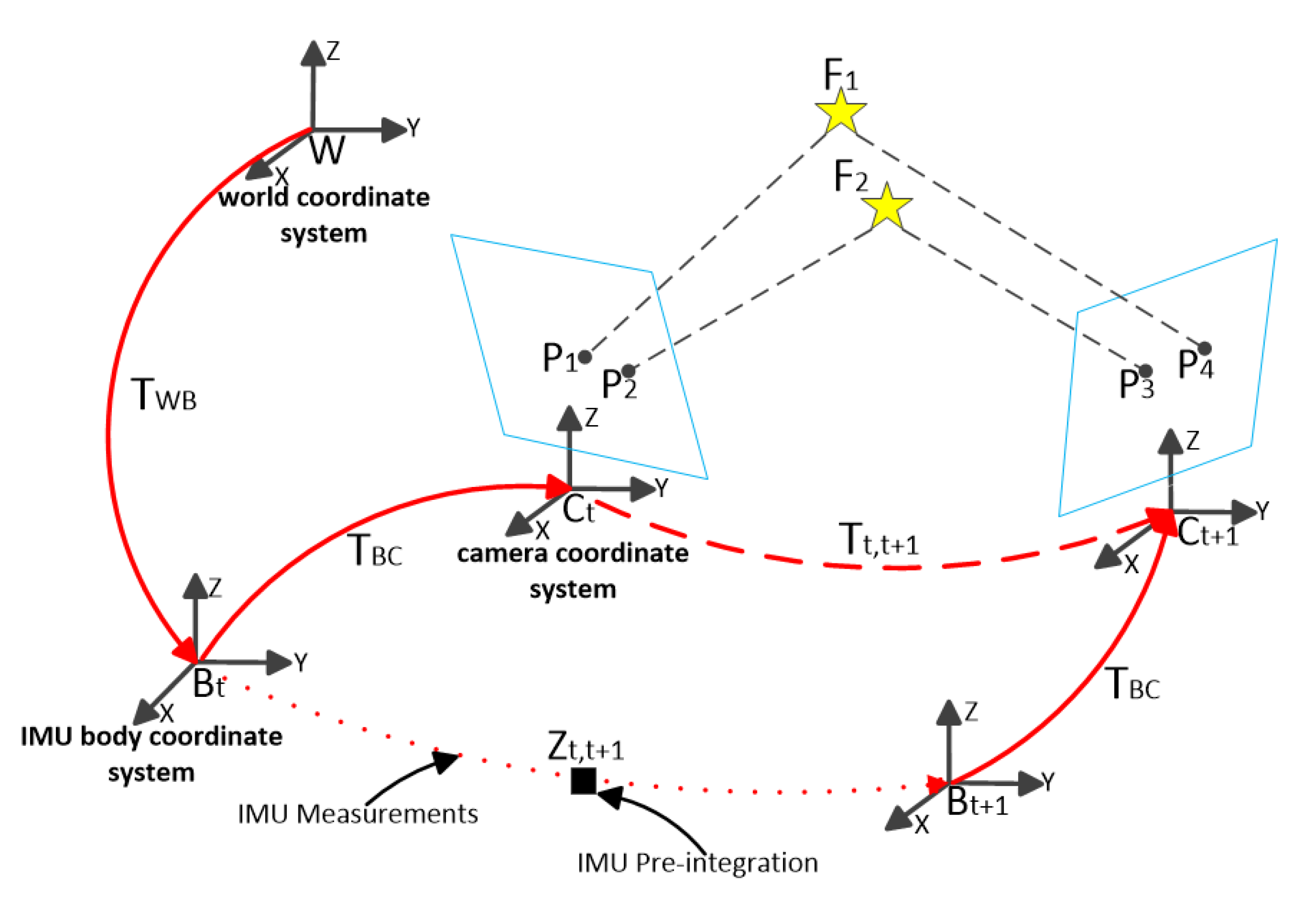
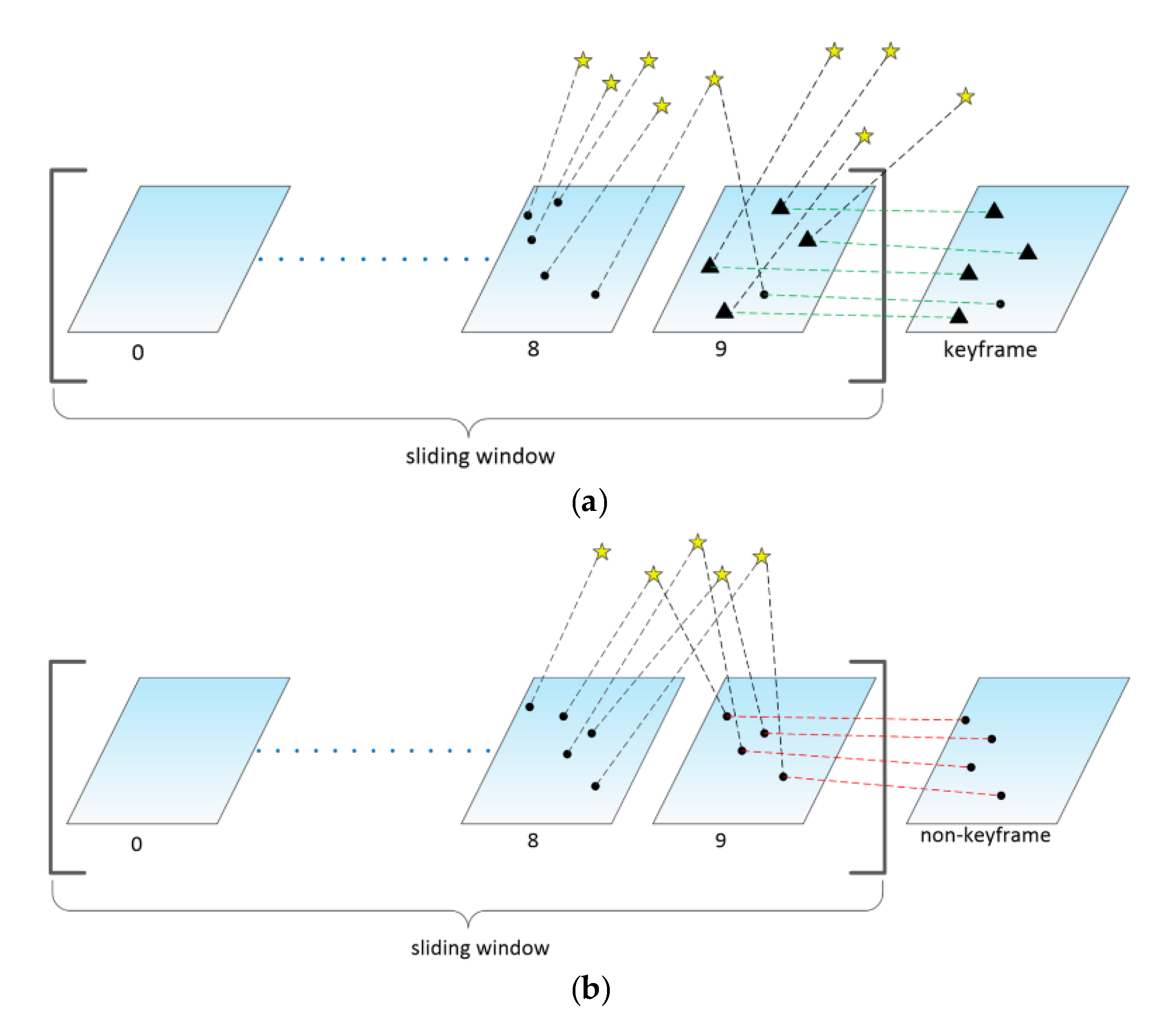
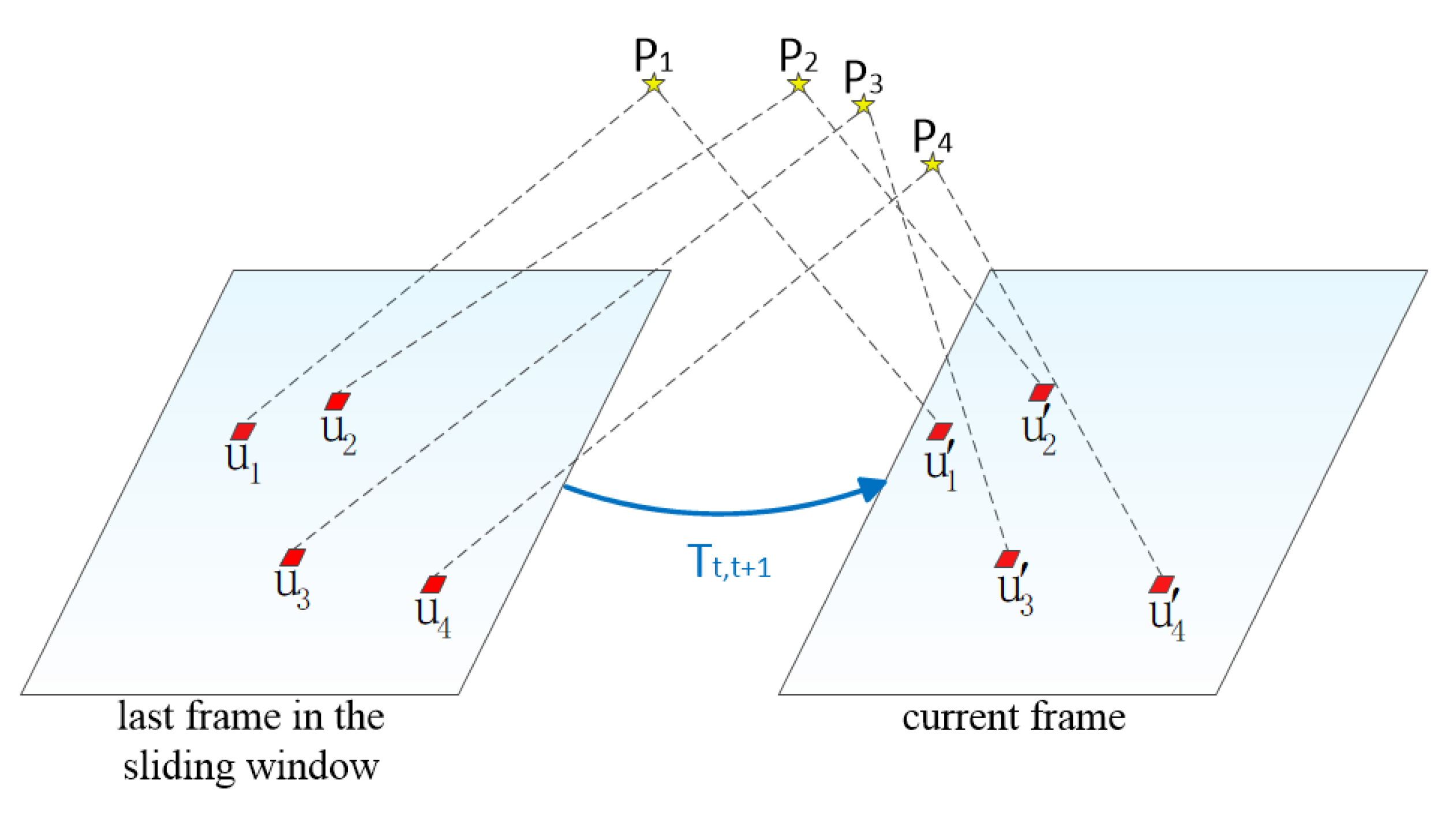
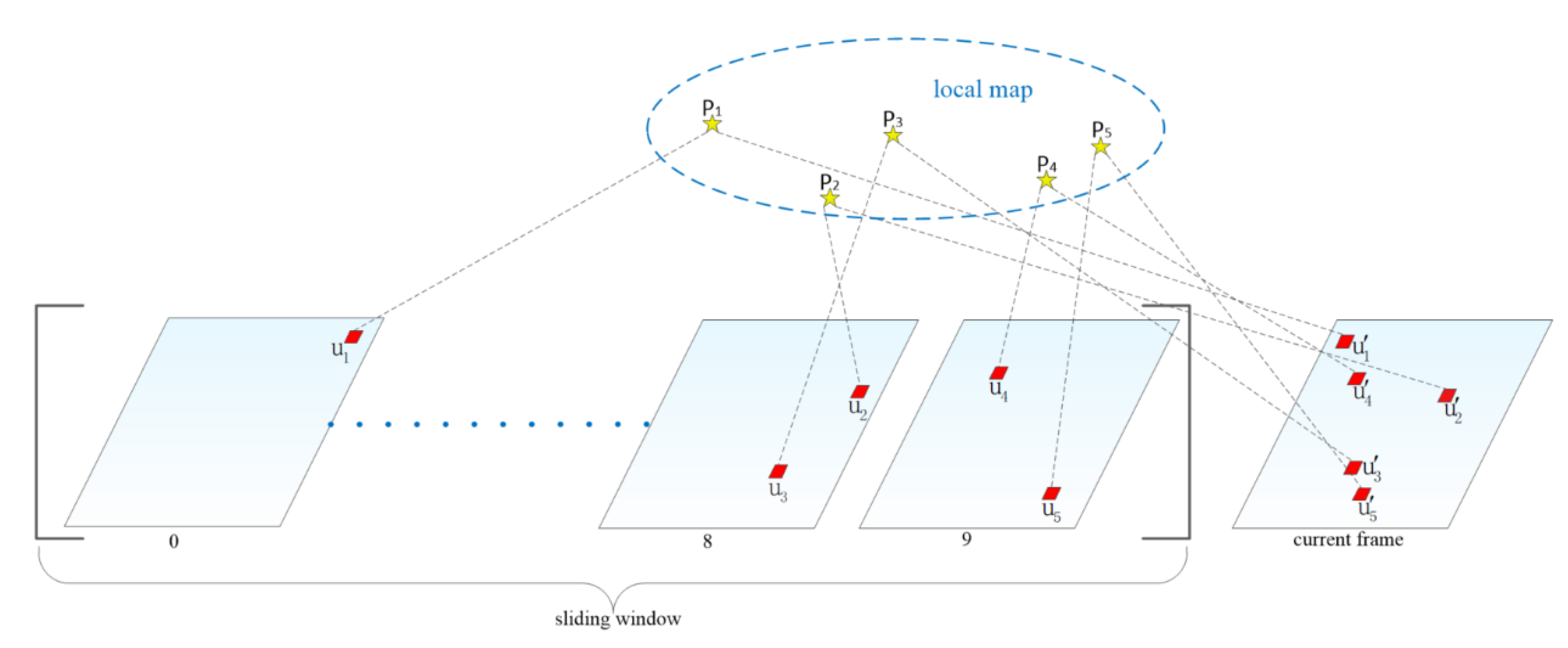
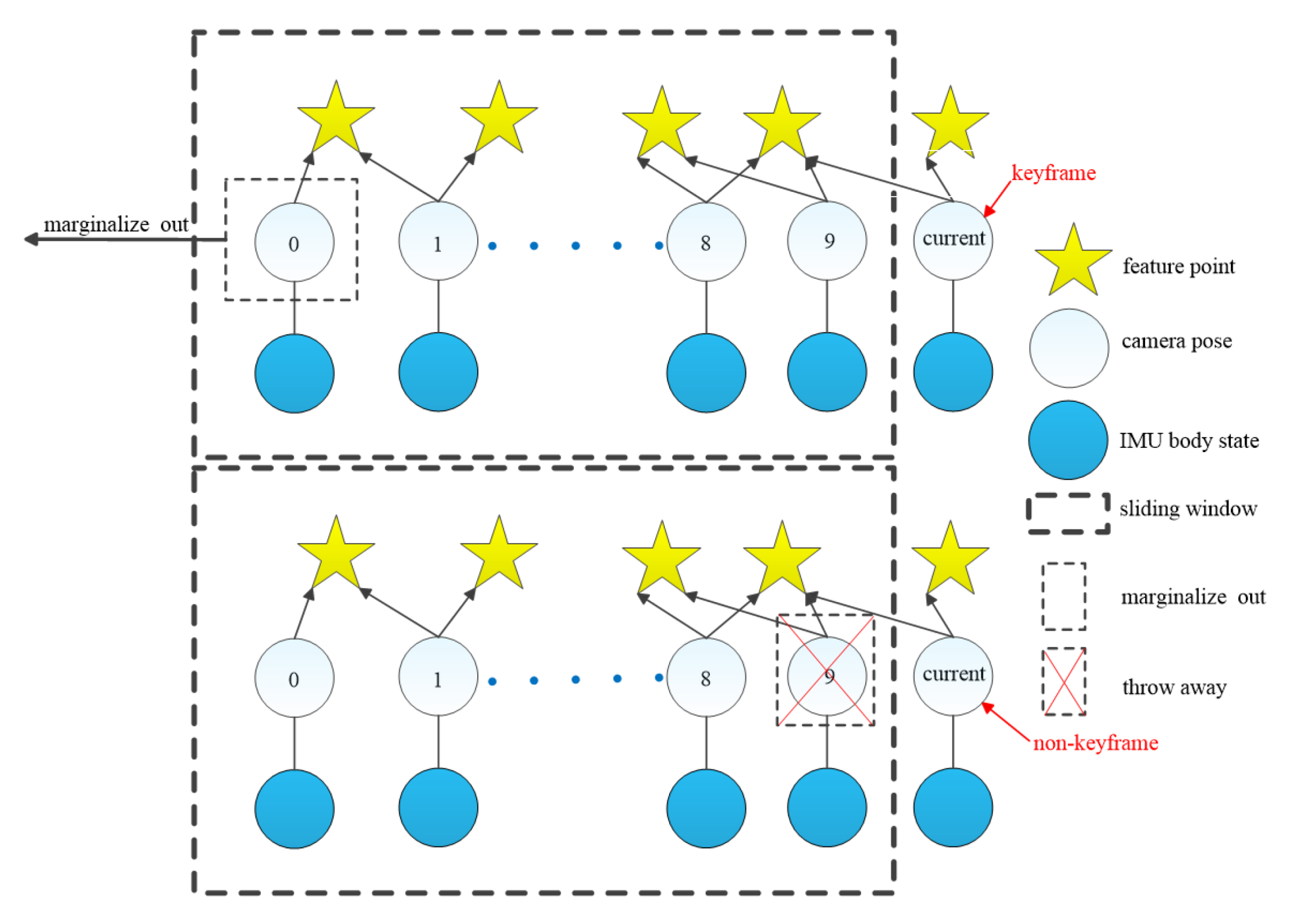
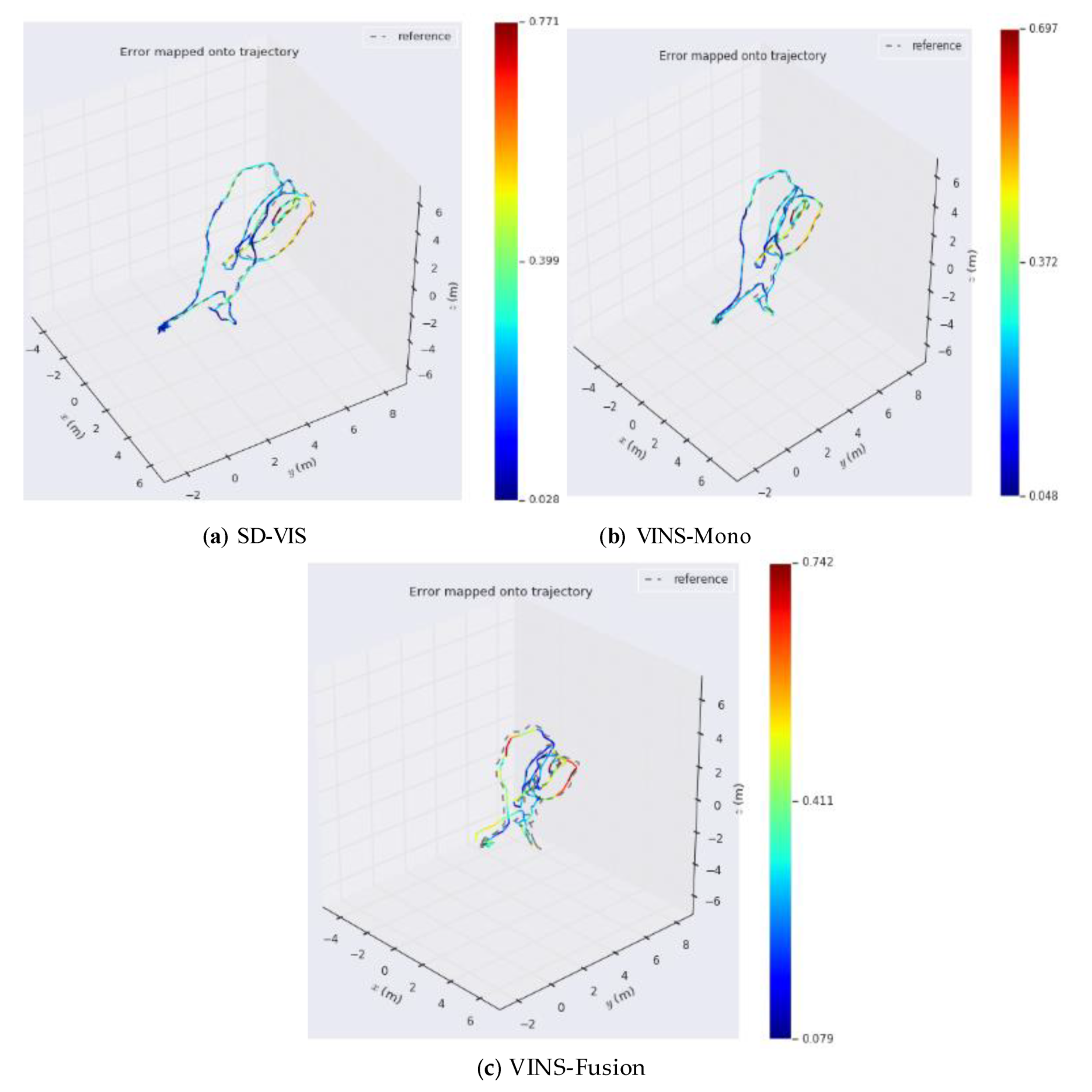
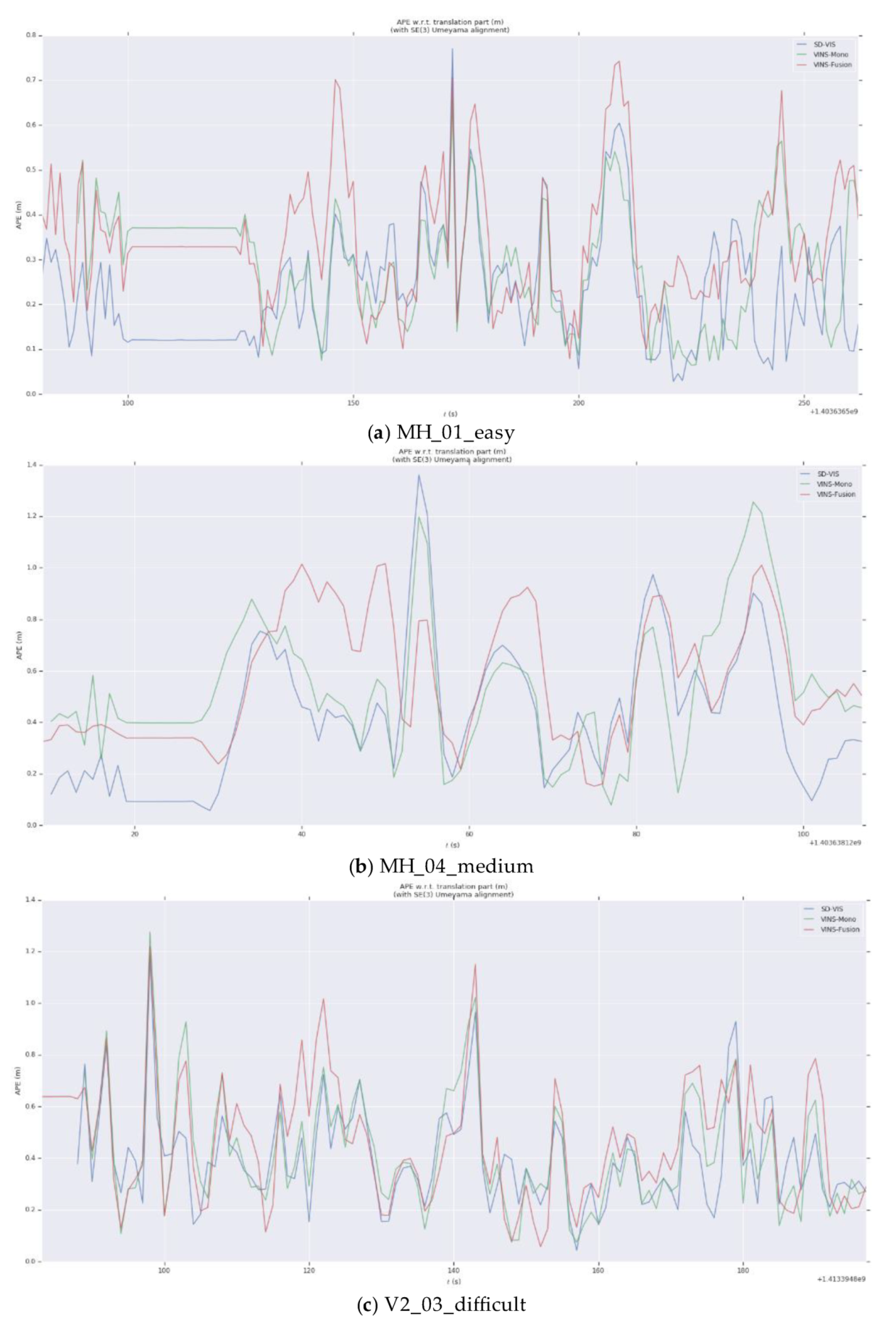
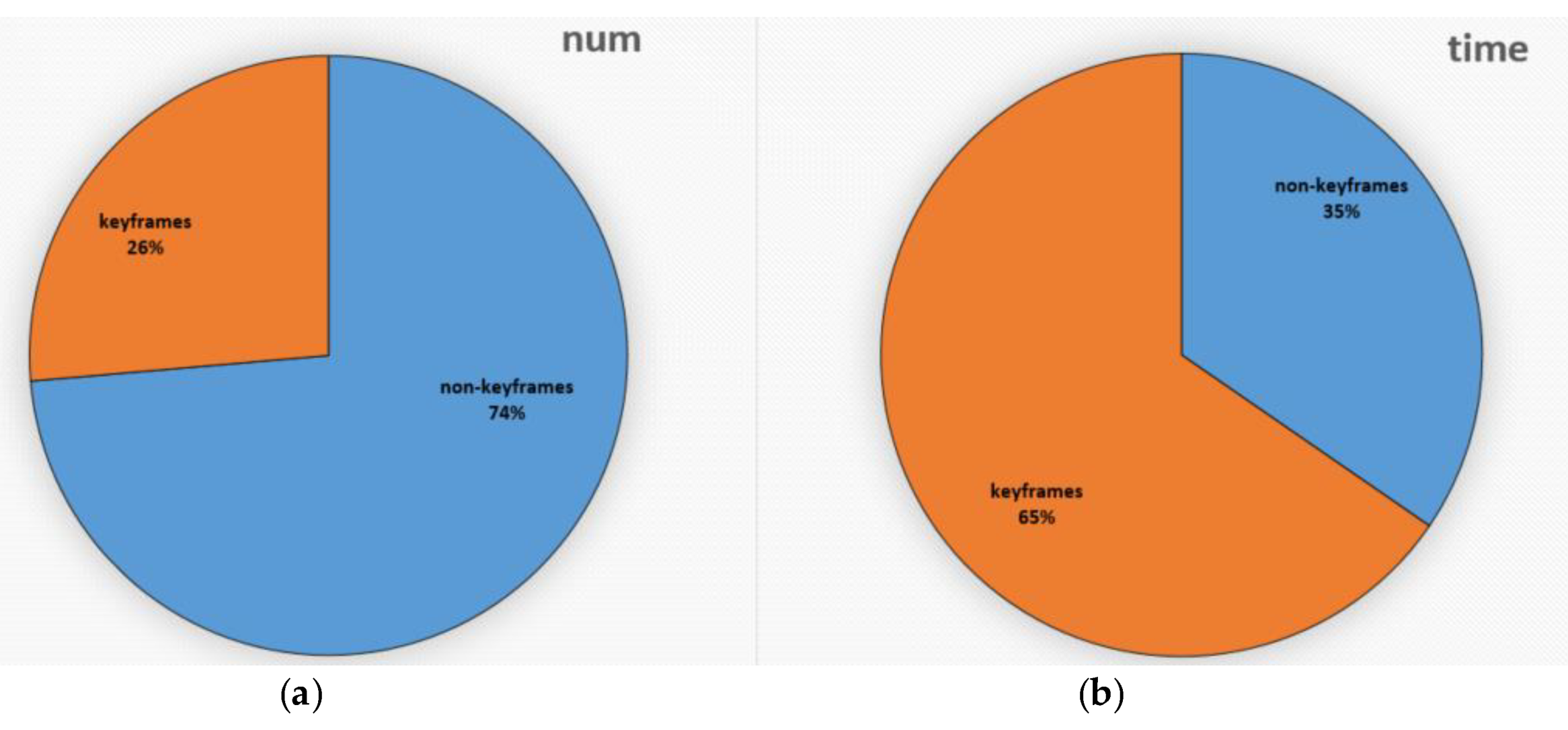
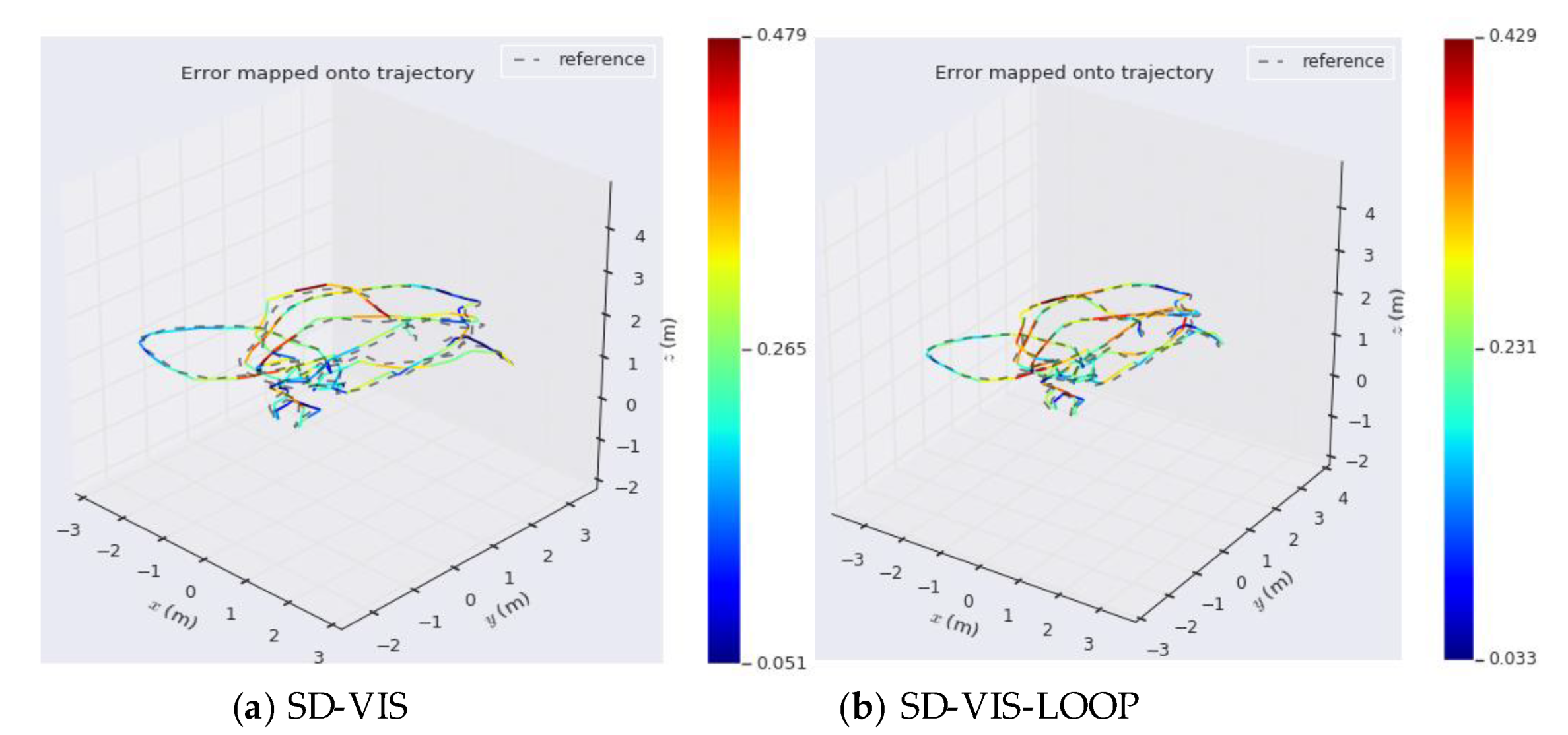
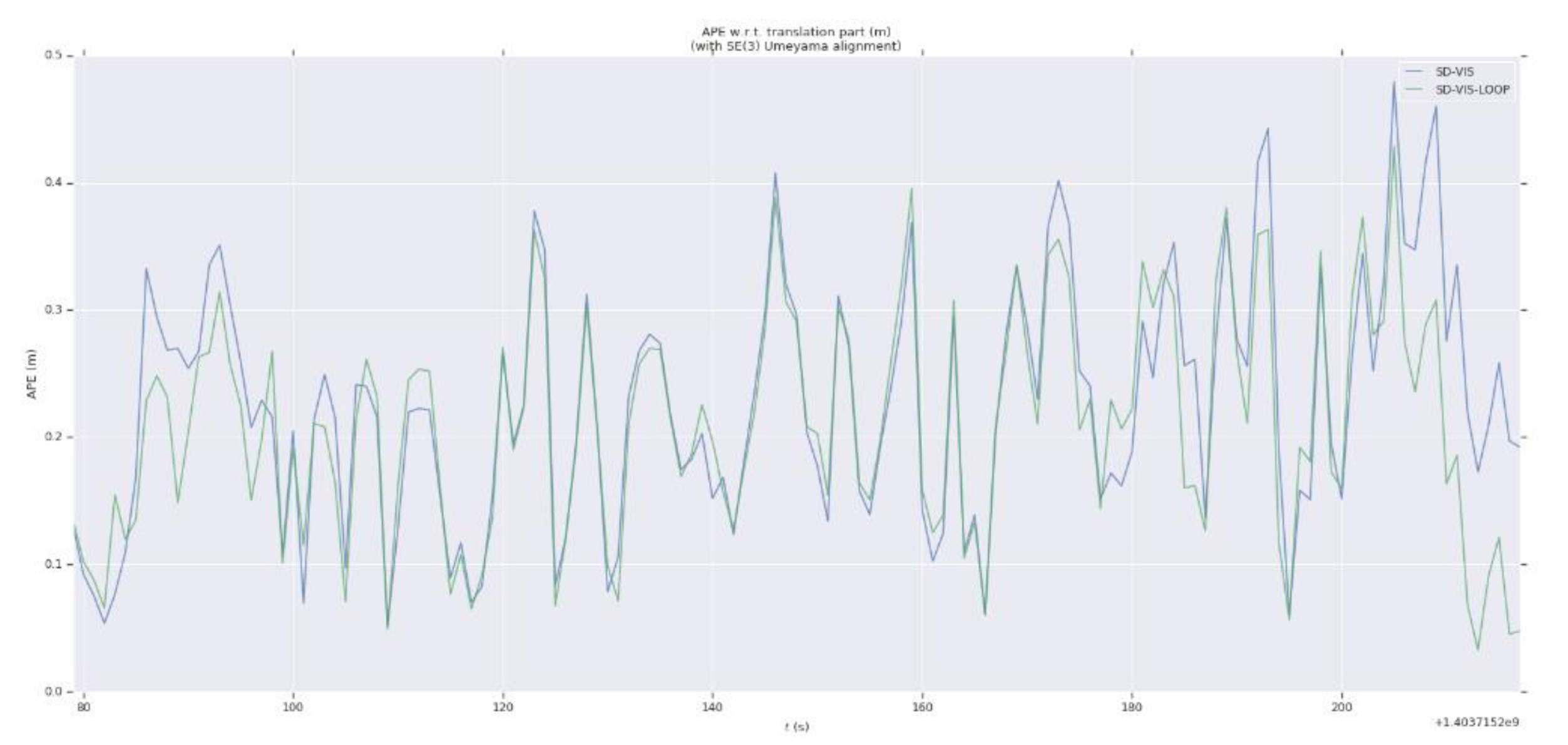
| Dataset | VINS-Mono | VINS-Fusion | SD-VIS |
|---|---|---|---|
| MH_01_easy | 0.254651 | 0.364247 | 0.260793 |
| MH_02_easy | 0.263258 | 0.339122 | 0.289663 |
| MH_03_medium | 0.547901 | 0.483257 | 0.577422 |
| MH_04_medium | 0.590191 | 0.614950 | 0.497288 |
| MH_05_difficult | 0.512011 | 0.524107 | 0.512458 |
| V1_01_easy | 0.217083 | 0.247467 | 0.245990 |
| V1_02_medium | 0.492645 | 0.434756 | 0.502134 |
| V1_03_difficult | 0.361521 | 0.345895 | 0.388959 |
| V2_01_easy | 0.170790 | 0.177467 | 0.202474 |
| V2_02_medium | 0.424259 | 0.370081 | 0.454785 |
| V2_03_difficult | 0.475561 | 0.521573 | 0.444759 |
| Dataset | ORB-SLAM2 | VINS-Mono | VINS-Fusion | SD-VIS |
|---|---|---|---|---|
| MH_01_easy | 37.82 | 17.67 | 38.91 | 6.72 |
| MH_02_easy | 35.31 | 13.60 | 45.86 | 6.58 |
| MH_03_medium | 34.20 | 12.28 | 44.15 | 7.87 |
| MH_04_medium | 30.35 | 12.92 | 42.54 | 6.93 |
| MH_05_difficult | 30.43 | 12.77 | 42.65 | 6.91 |
| V1_01_easy | 37.15 | 13.38 | 45.87 | 7.14 |
| V1_02_medium | 28.46 | 13.89 | 45.36 | 10.96 |
| V1_03_difficult | × | 13.50 | 44.40 | 7.81 |
| V2_01_easy | 33.01 | 15.30 | 49.10 | 6.28 |
| V2_02_medium | 31.13 | 13.04 | 45.56 | 10.22 |
| V2_03_difficult | × | 17.90 | 45.07 | 12.38 |
© 2020 by the authors. Licensee MDPI, Basel, Switzerland. This article is an open access article distributed under the terms and conditions of the Creative Commons Attribution (CC BY) license (http://creativecommons.org/licenses/by/4.0/).
Share and Cite
Liu, Q.; Wang, Z.; Wang, H. SD-VIS: A Fast and Accurate Semi-Direct Monocular Visual-Inertial Simultaneous Localization and Mapping (SLAM). Sensors 2020, 20, 1511. https://doi.org/10.3390/s20051511
Liu Q, Wang Z, Wang H. SD-VIS: A Fast and Accurate Semi-Direct Monocular Visual-Inertial Simultaneous Localization and Mapping (SLAM). Sensors. 2020; 20(5):1511. https://doi.org/10.3390/s20051511
Chicago/Turabian StyleLiu, Quanpan, Zhengjie Wang, and Huan Wang. 2020. "SD-VIS: A Fast and Accurate Semi-Direct Monocular Visual-Inertial Simultaneous Localization and Mapping (SLAM)" Sensors 20, no. 5: 1511. https://doi.org/10.3390/s20051511
APA StyleLiu, Q., Wang, Z., & Wang, H. (2020). SD-VIS: A Fast and Accurate Semi-Direct Monocular Visual-Inertial Simultaneous Localization and Mapping (SLAM). Sensors, 20(5), 1511. https://doi.org/10.3390/s20051511




